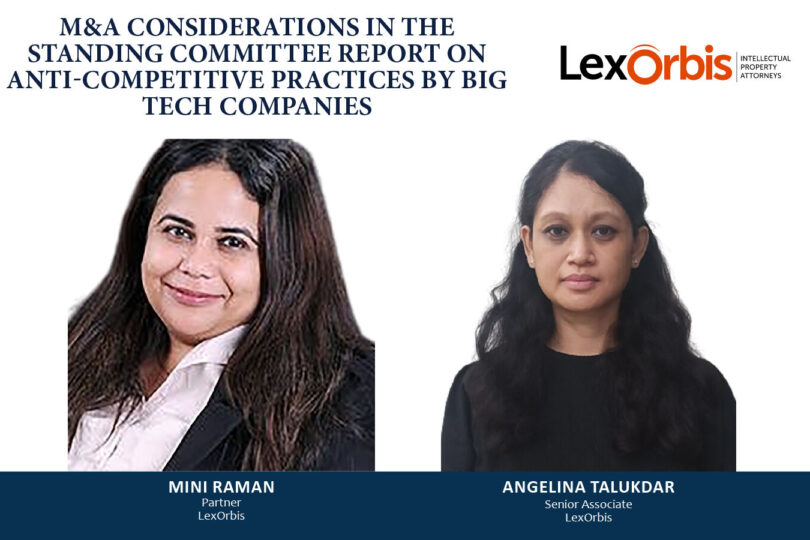
M&A Considerations In The Standing Committee Report On Anti-Competitive Practices By Big Tech Companies
The Committee observed that certain mergers and acquisitions involving Big Tech Companies, such as transactions forming part of the digital markets, do not meet traditional asset and turnover thresholds and therefore fall outside the ambit of the current competition law
The Standing Committee on Finance of the Ministry of Corporate Affairs (“Committee”) presented its report on ‘Anti-Competitive Practices by Big Tech Companies’ dated December 22, 2022 (the “Report”). The Report was formulated with a view to considering the regulation of anti-competitive methods undertaken by big tech corporations and the enactment of digital competition laws for a fairer, more transparent, and dynamic digital landscape.
Digital markets comprise internet-based (digital) companies with millions of interacting participants. The Report found that the underlying economic drivers of digital markets inevitably lead to the rise of a relatively few leading players collectively referred to as the “Big Tech Companies”. The rise of Big Tech Companies is due to the fundamental difference in the way digital markets operate, as compared to traditional markets. Digital markets are driven by massively powerful increasing return-to-size economies. There is an evident market tilt in favour of these big techs, with drastically increasing market volatility, and winner-take-all monopolistic outcomes. Moreover, leading players in one digital market can quickly unlock these increasing return effects in adjacent markets as well. Since digital markets do not have sufficient competition, they are also prone to significant anti-competitive behaviour by leading players1.
Based on the submissions received by the Committee on part of the various stakeholders and observations by the commission in its various orders, the Committee identified the ten Anti-Competitive Practices (“ACPs”)2. The competition law must largely address these ACPs in order to ensure market efficiency as well as fair competitive conduct.
The ten ACPs identified by the Report are as follows:
i. Anti-steering provisions
ii. Platform neutrality/self-preferencing
iii. Adjacency/Bundling and Tying
iv. Data Usage
v. Acquisitions and mergers
vi. Pricing/Deep Discounting
vii. Exclusive tie-ups
viii. Search and ranking preferences
ix. Restricting third-party applications, and
x. Advertising Policies
This article deals with the considerations of “mergers and acquisitions” as an “ACP” by the Committee in the Report.
Mergers and Acquisitions involving Big Tech Companies
The Committee observed that certain mergers and acquisitions involving Big Tech Companies, such as transactions forming part of the digital markets, do not meet traditional asset and turnover thresholds and therefore fall outside the ambit of the current competition law3. However, these transactions may still have an effect on competition. For instance, it was alleged in the Report4 that many acquisitions are “killer acquisitions” wherein Big Tech companies acquire smaller companies with innovative technology which may pose competition for them. They pursue the “buy” approach to acquiring high-valued start-ups with innovative technologies as opposed to building such technologies themselves. This may result in disallowing the smaller firms to grow in digital markets.
The Committee, therefore, proposed that necessary thresholds including a deal-value threshold for merger notification be provided for in the competition law to cover acquisitions in the digital markets. The Committee also recommended that a Big Tech Company proposing to undertake an acquisition should inform the Competition Commission of India (“Commission”) of any intended concentration, where the merging entities or the target of concentration provide services in the digital sector or enable the collection of data, irrespective of whether it is notifiable to the Commission. Further, the Committee are of the view that a Big Tech Company should inform the Commission of such a concentration prior to its implementation and following the conclusion of the agreement, the announcement of the public bid, or the acquisition of controlling interest.5
It is interesting to note in this context that (as deposed by industry stakeholders before the Committee), mergers and acquisitions are legitimate business transactions that companies pursue to increase value and obtain synergies. Big Tech Companies do not kill innovative technologies, rather they nurture entrepreneurs and innovation. Therefore, unnecessary regulation of mergers and acquisitions should be avoided if possible.
It is a plausible solution to bring in deal value as a parameter for acquisitions or mergers in the digital market for obtaining the approval of the Commission as acquisitions in the digital market are asset-light and may not trigger the currently specified thresholds for approval. As digital markets are distinct from traditional markets, specific deal value criteria may be introduced in the competition law for mergers or acquisitions in such markets.
However, the legal and economic landscape of the country should foster and facilitate transactions and businesses. Making the obtaining of the approval of the Commission a prior requirement instead of a post requirement would have the effect of increasing the burden of compliance by the acquirer. It would also mean a delay in the transaction timeline as completion would be dependent on obtaining the relevant approvals or intimation from the Competition Commission of India.
In our view, therefore, the current competition law may be amended to provide for deal value parameters specifically in mergers and acquisitions in digital markets. However, it is recommended that the requirement for the approval of the Commission be made after the signing of the definitive documentation and not at the implementation stage.
Disclaimer – The views expressed in this article are the personal views of the authors and are purely informative in nature.
1. Chapter 1, paragraph 1.2, Page 1
2. Chapter 1, paragraph 1.11, Page 4
3. Chapter 1, paragraph 1.21, Page 8
4. Chapter 1, paragraph 1.20, Page 8
5. Chapter 2, paragraph 2.18, Page 18
